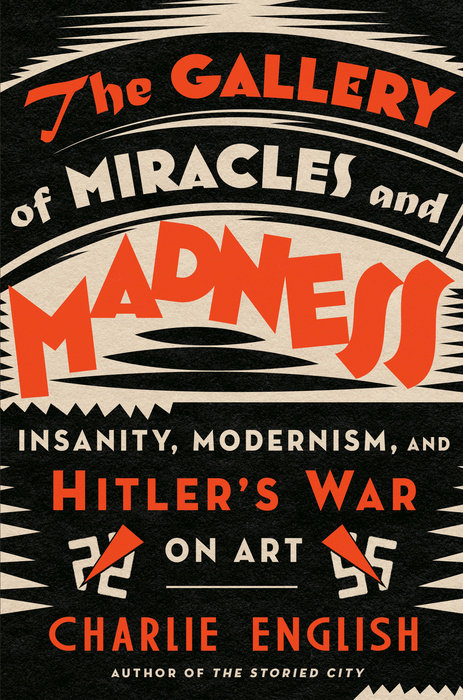The Gallery of Miracles and Madness: Insanity, Modernism, and Hitler’s War on Art, by Charlie English. Random House, 336 pages, 16 pages of plates, 2021. ISBN: 9780525512059. Hardcover, $28

Charlie English begins his history of Nazi cultural preoccupations— – and the genocides that followed— – with the story of Franz Karl Buhler, a German blacksmith who turned painter after he was overtaken by mental illness and entered an asylum. He also was an artist collected by the pioneering psychiatrist Hans Prinzhorn (who gave him the pseudonym Franz Pohl), and he was as well an early victim of Nazi genocidal policies.
Prinzhorn, and his famous collection of art by asylum inmates, played a major role in Germany’s 20thth -century culture wars, up to and including the Nazi’s assault on what they called “degenerate” art, an assault that ultimately included murder as well as ridicule.
I had viewed the Nazi concern with that degenerate this art as a weird and unfortunate example of their bad taste and manipulative cultural policies—, but not nearly as bad as what followed. But English makes the case that Nazi art policies were a forerunner and, ultimately, an integral part of the Holocaust.
Ands for those of us whose interest in Prinzhorn has extended little beyond the art brut he championed, English supplies fascinating and horrifying context. That includes a good deal of detail on Prinzhorn’s life. Besides being a physician and earning a Ph.D. in art history PhD, he was a professionally trained singer and a translator, among other things. And a man who had his own stumbles. In 1921 he diagnosed himself as “an unstable psychopath with hysterical traits.” And iIn 1932 he evinced sympathy for Hitler and the Nazis, admiring Hitler’s leadership abilities, it seems, and the prospect of national renewal, though he appears to have repented of that view before his death in 1933 as the Nazis consolidated their power.
Whatever his own flaws, as English says, Prinzhorn “rescued art from the diagnostic clutches of psychiatry and placed the previously despised art of the mentally ill on a pedestal, equal to or higher than that of some of the most vaunted artists in German history.”
English, a former arts editor and head of international news for Tthe Guardian, gives Prinzhorn and the power of the art he championed their due, but he devotes the rest of the book to the dark side of artistic engagement. Adolph Hitler, it seems, was just as passionate about art as Prinzhorn and his modernist admirers, and that passion fueled Hitler’s monomaniacal vision.
“Art gave Hitler a higher political purpose,” English writes, believing “the Germans would be judged by the quality of their cultural achievements and their monuments….”
“From every platform, [Hitler] styled a culture war, exploited the wide-spread antipathy Germans felt for modernity and modernism.”
Carl Schneider, the Nazi psychiatrist who later headed the Heidelberg Clinic where Prinzhorn had worked, put the Nazi view this way: Prinzhorn, by putting art all on one level, “whether it was a Rembrandt or a child’s scribble … opened the door to ‘’art for every good-for-nothing,’ as anyone, however inartistic, could claim metaphysical authority for his need for expression.”
We might take Schneider’s comments as a something of a backhanded endorsement of what came to be called art brut. But that’s trivial compared with the upshot of this particular culture war. The Holocaust got under way with the murder— — the Nazis called it euthanasia— — of the disabled, a group that included at least 30 Prinzhorn artists (so far identified), including Franz Karl Buhler.
This is a book about art and culture, but they are inseparable from politics – in Germany in the early 20th century and in the U.S. today as well. Our own culture wars would seem familiar to Germans of the 20s and 30s, with our far-right extremists raising many of the same issues as theirs, as well as pursuing similar opportunities to polarize the populace and grab authoritarian power.
Though English never once mentions Donald Trump, his account of Hitler’s rise makes clear that the seemingly facile comparisons of Trump to Hitler might have more substance than we think. But this book also makes the case that Hitler’s charisma was powered in part by his passion for art — a charisma that would have been impotent if he hadn’t surrounded himself with a talented coterie of officials. We can consider ourselves lucky that Trump himself seems to have no passion at all except for self-aggrandizement and golf, and that Trump and the people around him lacked the competence to pull off the kind of power grab to which they aspired and in which Hitler and his followers prevailed.
A version of this review originally appeared in The Outsider magazine, published by Intuit: The Center for Intuitive and Outsider Art.
